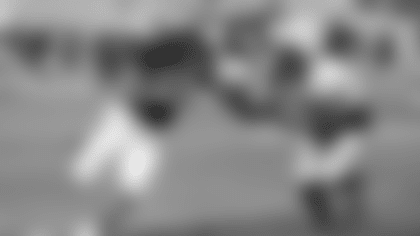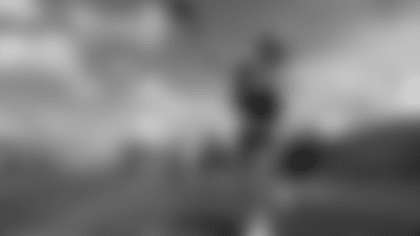"Guess what? We're going to Camp Snoopy!"
Even at a young age, I recognized that most of my peers would celebrate such a surprise announcement – I should be excited. But I wondered instead why my stomach knotted in fear.
I was sensitive, easily overwhelmed and oh-so-alert. I was that kid who covered my ears at a parade when fire trucks beeped their greetings and imagined burglars sneaking through a window of our home. Once in middle school, I had a friend over and my mom and sister ran a few errands; I called my grandma when they weren't home exactly at the calculated minute I'd anticipated, convinced there had been an accident.
I wanted to love animals as a child, but I laugh now at various memories: panicking when a baby goat nibbled food from my hand, or the time we went to downtown Anoka to feed the mallards and I ended up climbing to the safety of a picnic-table top. Dogs scared me – even our 3-pound toy poodle, Tina, for the first day or two – and those of you who know me recognize how far I've come in that arena.

Some young people outgrow anxious tendencies, but I never really did.
Normalize the conversation. Break down the stigma. It's OK to not be OK.
All of the above have been mantras throughout the "Getting Open" series. They're all sentiments in which I whole-heartedly believe.
I've learned a lot and welcomed tough conversations, and it's been my absolute honor to be trusted to share 11 incredible stories so far.
But there's one story I haven't yet told: my own.
As we wrap up this first "Getting Open" series and I reflect on dialogue I've had with every featured guest, I'm flipping the script for a moment. I'm not only passionate about this topic because it's important. I'm committed to raising awareness around mental illness because it resonates. I live it.
Early experiences

I always enjoyed school, but nonetheless, early morning stomachaches persisted for years. And as I got older, I battled immense levels of anxiety if I wasn't sitting at the end of a pew at church or in the last seat of a stadium row. Feeling "trapped" or getting sick in public have always been consuming concerns.
At 14, a diagnosis of Generalized Anxiety Disorder put words to the way I'd been feeling. It explained why my brain didn't seem to work quite the same as others.
Instead of intimidating, the diagnosis actually felt – in a way – comforting. I wasn't alone. I remember reading about anxiety online and thinking, "Yes! That's it. That's exactly what it's like!" A strange sense of relief.
Naming the problem doesn't fix the problem, but it certainly can help you feel less insecure about the challenges you face.
It just feels dark
And although there are absolutely common threads, anxiety disorders look different for everyone.
For me, it can show up in a variety of ways: nausea, and palms slick with sweat despite being icy to the touch. Fingers and toes riddled with pins and needles. The inability to focus. My brain sometimes feels like a skipping CD, and words spoken by others sound more like Charlie Brown's teacher.
The worst times are when it comes out of nowhere. When I'm lying on the couch watching a movie or tapping 12-down into The New York Times' crossword puzzle. Minding my own business, and that familiar wave of heat washes over my body, leaving behind frigid fingertips.
That feeling of dread, like something horrible is going to happen, but you just don't know what.
It's honestly hard to describe, other than it just feels dark. And when you can't put your finger on anything specific, it only intensifies: a sensation of chest or throat tightness, as you can imagine, doesn't relieve the unease. Rather, it snowballs – gaining size and speed as it rolls down the hill.

During my junior year of college, I faced an especially rough patch.
Professors received preemptive emails explaining I might need to excuse myself from lectures. If the class implemented a seating chart, I requested placement near the door. Leaving the dorm for dinner with a close friend loomed like an enormous task. I considered "taking a semester off" – but deep down, I knew that retreating to the comfort of my parents' home might translate to never returning.
So I stayed. And I'd be remiss if I didn't mention my Math for the Liberal Arts professor. He responded with such empathy that – although I've forgotten most of the numbers and formulas – I've never forgotten his compassion. He told me to not worry about being in class if I couldn't, and he offered to tutor 1-on-1 if necessary.
He might not realize it, but that professor truly helped me get through that semester.
By the time I reached my senior year, the clouds had cleared. I served as the sports editor for the school paper, worked on my senior capstone project and interned for the Timberwolves.
I can't imagine where the path might have led had I given in to the previous year's anxiety.

Dealing with a mental health disorder is a roller-coaster ride.
There are times I feel invincible and carefree and others when just getting through the day is exhausting. And occasionally, a bout of anxiety has developed into a panic attack.
For six years I worked as a server at Ruby Tuesdays, and I once had a panic attack toward the end of my shift. Everything sounded so loud – the clinking glasses, NASCAR whirring on the bar TVs, a chocolate-colored crouton crunching beneath my rubber-soled shoe. I have this really weird, distinct memory of a particularly rough brick on the building's exterior catching my black T-shirt and scraping my shoulder blade as I slid to sit and worked to breathe.
It feels like someone pushed "fast forward" on the world around me. You know those dreams where you try to run as fast as you can, but your legs feel like lead? That sensation is sometimes real life.
While interning with the Wolves, I had a handful of brief interactions with second-year forward Kevin Love, who played six years in Minnesota before being traded to Cleveland in August 2014.
Love shared a piece of his own mental health story via The Players’ Tribune in March 2018, and I've never felt more understood by these lines:
When I got to the bench, I felt my heart racing faster than usual. Then I was having trouble catching my breath. It's hard to describe, but everything was spinning, like my brain was trying to climb out of my head. The air felt thick and heavy. My mouth was like chalk. I remember our assistant coach yelling something about a defensive set. I nodded, but I didn't hear much of what he said.
Similar to when I first read about the symptoms and tendencies of anxiety, there's something almost soothing about finding someone who understands, better than most, what it's like to live in your skin.
It's why this "Getting Open" series has been so important to me.
Over the past 11 weeks, I've helped tell a variety of stories around mental health. I appreciated talking to Eric Kendricks and his fiancée Ally about their journey and experience around depression. I was encouraged by Jalyn Holmes' honesty about anxiety battles, and I was inspired by Tyler Conklin and Harrison Hand's willingness to share and reflect on attentiveness to their mental well-being.
I've valued the collaboration with KFAN's Chris Hawkey and Paul Allen, and I'm beyond grateful for the genuine support shown to this series by Vikings General Manager Rick Spielman and Chief Operating Officer Andrew Miller.
If Eric, Ally, Jalyn, Harrison, Tyler, Hawkey, PA and others sharing their stories can help encourage someone going through a difficult time, it matters.
Like Jalyn said: "If it helps one person, it's worth it."
Struggle, spiral and support
It's why I knew I needed to share. To be honest, it's been weighing on me for a while now – I've always wanted to help other people through my experience. Because while I may struggle with anxiety, am emotionally sensitive and get easily overwhelmed, there's the flip side that I wouldn't trade for the world: the empathy, compassion and desire to connect with and care for those around me.
I've even been encouraged to more widely share, but I just wasn't ready.

Throughout this entire series, various guests have talked about the difficulties of the past 13-plus months. Between the coronavirus, political and societal unrest and racial injustices, 2020 and beyond has been heavy for everyone in so many ways.
One thing about me is that I've always wrestled with a lot of medical anxiety. So when the pandemic hit, I – like many, many others – found myself seriously struggling emotionally and mentally.
What if I get seriously ill? What if I'm carrying the virus and infect someone I care about? What if I lose a loved one to this disease?
(Spoiler alert: "What if" is a common go-to when dealing with anxiety.)
Being cautious is a recurring theme for me, and I followed the same approach with this. But in late October, I tested positive for COVID-19.
I'm thankful that, medically speaking, I had a mild/moderate case, but my heart breaks for those who have suffered significant, painful losses. Physically, I started to recover. The fever broke, the shortness of breath lessened and I gradually regained energy.
But mentally, I spiraled into a dark place. The anxiety disorder quickly became a panic disorder that relentlessly pummeled my brain and body. For days that turned into weeks, I struggled to eat or sleep, and I couldn't do the job I sincerely love.
On Nov. 23, I sent a group text to my roommate and two of our close friends:
Friends, I really need prayer. I've never been this low or this scared in my life. I can't see the light at the end of the tunnel.
For the first time in my life, I can say I understood the true meaning of hopelessness – and it's something I don't wish on anyone.
I truly wondered if the sun would ever come out again.
But it did.
It was a slow process and a journey I'm still very much walking. I'm so thankful, though, that I kept putting one foot in front of the other – with a lot of help from all sides.
We've talked a lot about support systems throughout this series, and I'll reiterate that theme. Whether friends, family, coworkers or neighbors, check in on your people … and allow them to check on you, too.
There were many nights of tearfully and fearfully talking and praying with my mom over the phone. She's been my rock many times, and this experience was no exception.
Exchanging texts and messages with my dad and sister – and receiving cute videos of my 4-year-old niece and nephew – reminded me that I wasn't alone.
Friends and coworkers checked in and offered support, and my roommate was an unwavering presence.

Faith in Jesus is foundational for me.
Listening to For King & Country playlists and TobyMac songs became part of my daily routine, and I've loved the Glorify app. My favorite Bible verse, Joshua 1:9, replayed in my mind.
Certain practices have been part of my life from a young age – deep-breathing exercises, focusing on nutrition, getting outside and (ironically) spending time with dogs – and I've taken additional steps, as well. I've started consistently seeing a therapist, and I can echo what Tony Richardson said in his feature: It's a wonderful thing to have that outside party to talk to. She's simultaneously a sounding board, a teacher and a caretaker, helping me work on various coping mechanisms and encouraging me to be truly vulnerable.
Additionally, I've utilized medication. I currently am navigating that sometimes-tedious process to find the best fit for me.

My journey isn't over. There are wonderful days, and there are really hard days. But I know I want to help other people.
Early this winter, I came across a post by The Depression Project that Jalyn shared on his Instagram Story. It struck a chord with me, and I realized something: This is my time. It's time for me to take my own advice: talk about it, be vulnerable and normalize the conversation. I hope to continue honoring the experiences of others, as well, so that collectively we can keep the momentum.
It's OK to not be OK.
By: Lindsey Young
You are not alone. If you or a loved one are struggling today, please reach out for support.
National Suicide Prevention Lifeline: 800-273-8255
NAMI (National Alliance on Mental Illness): nami.org
NAMI MN: namimn.org | 651-645-2948
This is the 12th installment of our Getting Open series. – and while it's wrapping up the weekly segments for now, we certainly plan to have more content around this crucial topic in the future.
Check out earlier features and keep an eye on the Vikings digital platforms for content down the road:
- Jalyn Holmes’ Describes Battle with Anxiety
- Eric Kendricks & Ally Courtnall Engage in Supporting Mental Health
- Tyler Conklin’s Family Develops Outreach After Tragic Loss
- Harrison Hand Uses Self-Care to Focus on Mental Health
- Vikings Leadership Provides Empathy, Organizational Support for Mental Health
- Chris Hawkey Battles OCD & Depression on Quest to ‘Happy’
- Thielen Foundation Addressing ‘Overlooked’ Mental Health of Youth
- Alexander Mattison Raising Awareness for Suicide Prevention
- John Randle Helping Connect Legends Community with Mental Health Resources
- Tony Richardson Goes from Pro Bowl Fullback to Full-Time Advocate
- Paul Allen Explains Lasting Impact of the COVID-19 Pandemic






